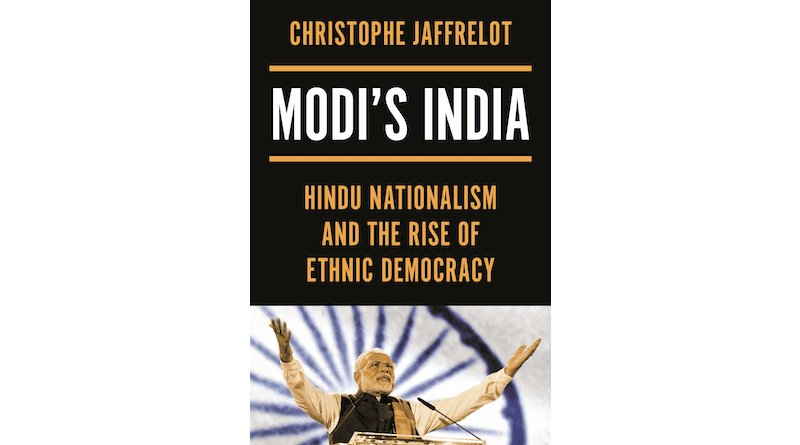Christophe Jaffrelot’s ‘Modi’s India: Hindu Nationalism And The Rise Of Indian Democracy’ – Book Review
In recent times, there is growing concern about the retreat of liberal democracy worldwide, with India, the world’s largest democracy, being no exception. It is showing visible signs of democratic ‘backsliding’ and ‘regression,’ which, if left unchecked, could lead to the emergence of an autocratic regime.
This phenomenon reflects Alexis de Tocqueville’s age-old apprehension that democracy might deteriorate into anarchy, ultimately resulting in the government accumulating excessive powers and centralizing control, rendering the population subservient and conforming—a concept known as ‘democratic despotism.’ Christophe Jaffrelot delves into these Tocquevillian concerns about democracy in contemporary India under the leadership of Narendra Modi. He seeks to answer a pivotal question: Why is India, a country long seen as an outlier in the post-colonial world for successfully sustaining its democracy, losing its democratic grip? A substantial part of the answer can be found in the book’s subtitle.
Jaffrelot constructs his narrative, which begins by examining the evolution of Indian democracy through three distinct phases. It starts with ‘conservative democracy,’ despite having a progressive constitution. During the Nehru and Indira Gandhi eras, India couldn’t realize its potential for deeper democratic consolidation. The Congress party, entangled in clientelist politics, hindered Nehru from implementing crucial land reforms and achieving his vision of establishing a ‘socialistic pattern of society.’ Jaffrelot notes that Nehru paid little attention to the notion of positive discrimination, reflecting elements of ‘conservative democracy.’ Similarly, Indira Gandhi struggled to make significant progress in land reforms and took an authoritarian and socially conservative path during the declaration of emergency. The next phase, described as the ‘democratization of democracy,’ coincides with Jaffrelot’s concept of a ‘silent revolution,’ marked by the ascension of lower-caste representation in north Indian politics and the declining involvement of upper-caste and middle-class voters in the democratic process. In response to this ‘silent revolution,’ Jaffrelot observes a counter-revolution aimed at instituting ‘ethnic democracy.’
The first part of the book introduces the argument that there has been a shift in the understanding of India, driven by Hindu nationalist aspirations for power, especially in the context of Hindutva and populist politics. Narendra Modi was chosen by the Bharatiya Janata Party (BJP) to be the Prime Minister in 2014, with a mandate to implement the ‘Gujarat Model’ of politics on a national scale. This model aimed not only to counter the ‘silent revolution’ but also to embed Hindu nationalist populism by generating fear of Islamist backlash, portraying Muslims as ‘the other,’ and rekindling a Hindu sense of vulnerability and inferiority. Modi, who had previously served as the Chief Minister of Gujarat, successfully employed tactics based on hope, fear, and anger to become the leader of all electoral campaigns in India after 2014. However, Jaffrelot argues that the Modi government, while rich in pro-poor rhetoric, had policy outcomes that primarily benefited the affluent, exacerbating economic inequality.
The second part of the book presents a comprehensive framework that argues India is transitioning from being the world’s largest constitutional democracy to becoming the world’s largest de facto ethnic democracy. Jaffrelot identifies various instruments used by Modi’s government to facilitate this transition, such as promoting a ‘Hinduized’ public space through laws on cow protection and conversions, emphasizing ‘Bharat’ over modern India, allowing RSS influence in state institutions, revising history to accommodate Hindutva politics, challenging left-liberal ideologies, restraining civil society organizations, reshaping education to align with Hindutva’s historical and scientific narrative, and undermining the practice of secularism. Targeting both Muslim and Christian minorities and fomenting violence against them is highlighted as a distinct method employed to transform India into an ethnic democracy. Jaffrelot contends that vigilantes, both in the digital and physical realms, propagated violence against minorities in collaboration with state authorities, especially the police, leading to the foundations of a ‘de facto Hindu rashtra.’
The final section of the book delves into the various facets of authoritarianism under Narendra Modi’s leadership. It explores the connections between populism, homogenization, polarization, and authoritarianism. Nationalist-populist leaders often tend to become authoritarian, and Jaffrelot argues that Modi’s ‘ethnic democracy’ project requires the capture of all branches of the government, including the media, and the deinstitutionalization of democratic institutions. This project underscores the significance of elections in terms of ‘electoral authoritarianism’ and perpetuates the identification of others as the enemy. In the concluding chapter, Jaffrelot highlights that Indian Muslims not only face social marginalization but also institutional exclusion and judicial marginalization.
In summary, Jaffrelot’s book provides a critical assessment of India under Narendra Modi’s leadership, asserting that it is evolving into an ethnic majoritarian democracy and leaning toward illiberal democracy. Subsequent political events have only served to further substantiate India’s democratic backsliding. While the book is comprehensive, it remains engaging and accessible, offering a descriptive yet thought-provoking analysis of India’s evolving democratic landscape.


Jaffrelot should peer into his own backyard and perhaps mind his own business. What a waste of time.
Indians must stop pretending that they can simply erase the minority question by political repression. There are 20 crore Muslims and other non-Dharmic peoples in India; in a climate of constant sectarian struggle chaos involving a great multitude of people is inevitable.